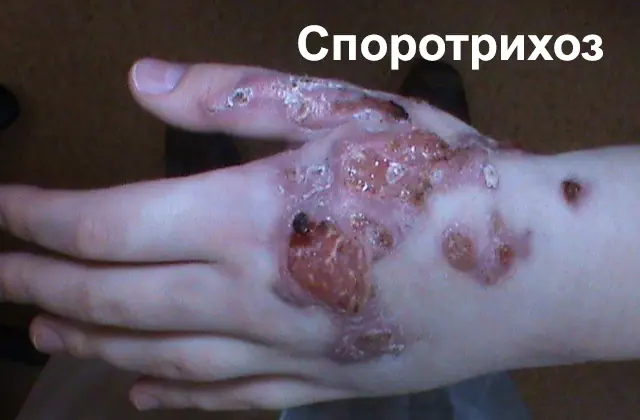
What are the causes and symptoms of sporotrichosis in humans? Diagnosis of sporotrichosis, proper treatment, diet. Prevention of disease.
The content of the article:- What is sporotrichosis
- Main reasons
- Developmental symptoms
- Treatment options
- Medicines
- Folk remedies
- Diet
Sporotrichosis is an infectious disease that develops against the background of damage to the body by the filamentous fungus Sporothrix schenckii. It occurs in an acute form, which without treatment becomes chronic. The disease most often develops against a background of reduced immunity, manifests itself in the form of ulcers at the sites of injury or spreads through the lymph nodes. If left untreated, the disease can spread to the bones and internal organs. Treatment is carried out in a hospital and is selected depending on the form of the disease. At this time, it is important to follow a diet, and after that - prevention. The disease also goes by other names: Berman-Gougereau disease, Schenk disease; in old reference books the term “gardeners’ disease” is often used, since they are the ones who most often come into contact with plants and are at risk of infection.
What is sporotrichosis?
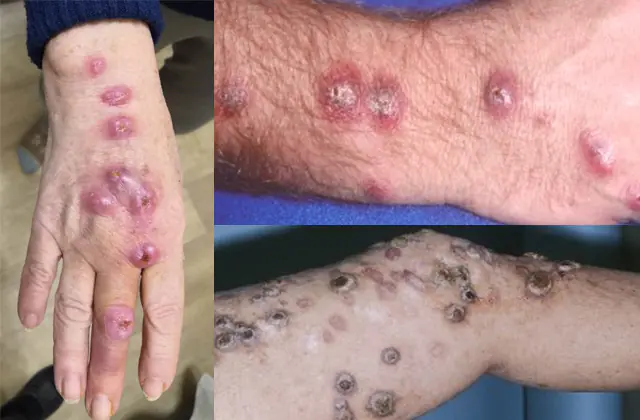
In the photo there is sporotrichosis on the arms and legs
Sporotrichosis is a serious infectious disease caused by fungal spores and often develops into a chronic form. The disease is widespread, but the highest incidence (1 case per 1 thousand people) is observed in tropical countries. As a rule, people aged 20-50 years suffer from the disease. Men are infected with the pathogen somewhat more often than women.
As noted above, the causative agent of sporotrichosis is the filamentous fungus Sporotrichium schenckii, which parasitizes the human body in tissue form (round or oblong cells 2-5 µm long) and in the form of thin mycelium (length - from 2 to 6 µm).
The distribution area of the Sporothrix fungus is all warm regions, especially the tropics and subtropics. It lives mainly on plants, living or withered, and on shrubs. It can often be found on the thorns of, for example, hawthorn or roses; it can settle in straw and sphagnum. You can also get infected from sick animals - most often cats or horses, as they are carriers of Sporothrix.
Infection occurs when fungal spores enter damaged areas of the skin (wounds, cuts, abrasions), they penetrate the inner layer of the epidermis and begin to reproduce. Infection also occurs when a plant is pricked by a thorn.
It is less likely to become infected with filamentous fungus by inhaling or ingesting its spores.
A person with sporotrichosis is not contagious to others, since direct contact of injured skin with fungal spores is necessary for transmission of infection.
The main reasons for the development of sporotrichosis
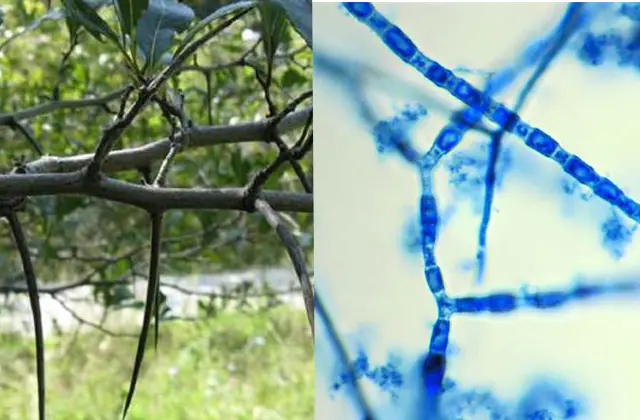
In the photo on the right is the filamentous fungus Sporothrix
Most often, sporotrichosis affects people involved in agriculture or those who simply like to work on the land - gardeners, foresters, as well as flower sellers and employees of paper factories.
However, infection with Sporothrix is not the only cause of sporotrichosis, since the development of the disease is not always observed when infected with this fungus. This requires predisposing factors:
- Weak immunity. A person does not have enough strength to fight the fungus, and the disease develops successfully. It is people with weak immune systems who are most susceptible to infection with Sporothrix.
- Serious illnesses. Their presence is directly related to decreased immunity. Thus, the likelihood of developing sporotrichosis increases in patients with HIV infection, diabetes, oncology, with complicated hematopoiesis and even depression.
- Hormonal disbalance. The use of hormonal drugs destabilizes our body, so during this uncomfortable period, infection with a fungus guarantees the development of the disease.
Symptoms of the development of sporotrichosis
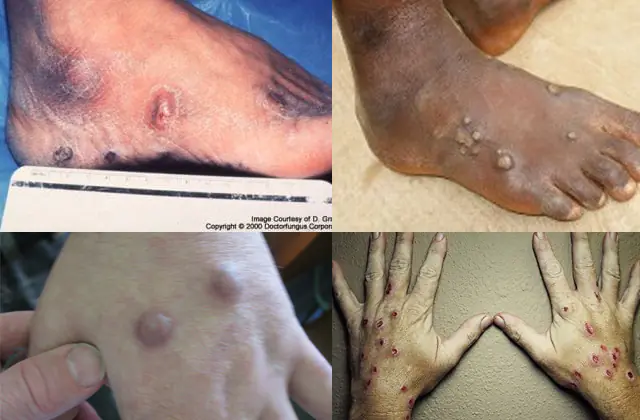
The first symptoms of the disease can appear either very early - 3 days from the moment of infection, or very late - after 12 weeks. Sporotrichosis can develop at the site of fungal infection, and when its spores enter the lymph nodes, the pathogen spreads through the lymphatic vessels.
Most often, the disease manifests itself within 2-3 weeks. General symptoms of sporotrichosis include nausea, dizziness, fever, and insomnia. The ulcers formed by the disease do not cause pain.
The characteristic symptoms of sporotrichosis depend on the form and stages of the disease:
- Skin-lymphatic. It shows itself quite quickly. At the site of infection by the fungus, a mobile compaction appears, which grows over time. Most often this is the back of the hand. A purulent fistula forms at this site, which subsequently breaks through. These foci of inflammation appear everywhere along the line of blood vessels, affecting the tissue under the skin. Often ulcers occur on the mucous membranes of the nasopharynx. Infection can penetrate into bones and joints.
- Disseminated. This form of sporotrichosis is extremely dangerous, as the fungus enters the bloodstream and can affect internal organs - the lungs and brain. Ulcers spread throughout the infected body: along the limbs, face, mucous membranes of the eyes, and do not appear only on the palms and soles. It is extremely important to correctly diagnose the form of the disease, because if it is treated incorrectly, it can develop with renewed vigor. This can lead to serious complications such as blood poisoning, which can lead to death.
- Pulmonary. This form of sporotrichosis can be confused with pneumonia or severe tuberculosis. As the disease develops, a strong persistent cough, shortness of breath appears, the throat turns red, the lymph nodes become enlarged, general weakness, fever, and chills appear. X-rays reveal changes that accompany infection in the body. If timely treatment is not started, the patient may develop pulmonary failure.
- Osseous-composite. The final point in the development of the disease, when the fungus affects the bones and joints. This type of sporotrichosis is fraught with complications in the form of arthritis and arthrosis. The disease develops very slowly, gradually growing in the joints of the elbows and knees, changing the shape of the bone tissue. Sometimes fistulas form at the site of the lesion. If left untreated, the fungus can invade the brain and cause meningitis.
Methods for treating sporotrichosis
The main method for identifying Sporothrix fungus is biopsy. The resulting material for processing is placed in a medium nutritious for the fungus and its spread is monitored. To diagnose pulmonary sporotrichosis, it is necessary to take an x-ray and distinguish it from tuberculosis, pneumonia, plague, osteomyelitis, and damage by other fungi. X-rays are also used in diagnosing osteoarticular forms to identify signs and concomitant diseases. In order to track fungal damage to internal organs, ultrasound is used. Based on the symptoms, a treatment regimen for sporotrichosis that is most suitable for the patient is drawn up.
Medications for sporotrichosis
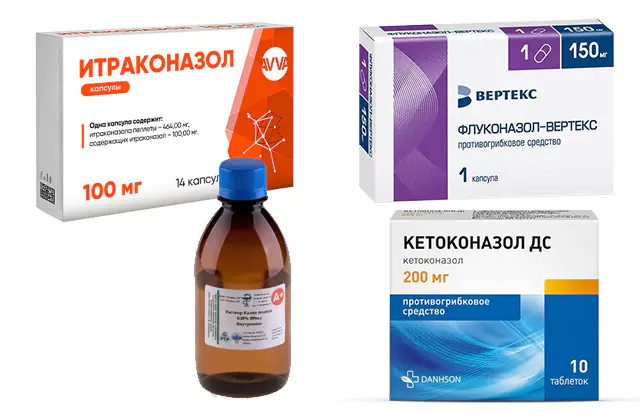
To prescribe the correct treatment for sporotrichosis, the doctor takes into account the form of the disease, its extent and severity. Thus, the treatment regimen is selected individually for each patient.
The main medications for the treatment of sporotrichosis are antifungal drugs:
- Itraconazole. An antifungal drug that is the basis for the treatment of this disease. Always used for its cutaneous form. The medicine is taken 100 g after meals for 3 to 6 months as prescribed by a doctor. The average price of the drug is 359 rubles in Russia (500 hryvnia in Ukraine).
- Potassium iodine solution. Can be used instead of Itraconazole. The initial dose is 10 drops per cup of milk. Every day for 2 months the dose is increased by 1 drop. The average price of the drug is 20 rubles in Russia (65 hryvnia in Ukraine).
- Fluconazole. Used for addiction to Itraconazole or for intolerance to it. Take 400 g of the drug on the first day, then 200 g per day. The average price is 36 rubles in Russia (19 hryvnia in Ukraine).
- Ketoconazole. Prescribed for patients with immunodeficiency. The medicine is taken with meals, 200 mg per day. The average price of the drug is 295 rubles in Russia (169 hryvnia in Ukraine).
- Amphotericin C. It is administered to the patient through a dropper every 4-6 hours. Voriconazole can also be used instead. Used in the treatment of pulmonary form.
- 5-fluorocytosine. It is used if the fungus has infected the brain, which is extremely rare.
Treatment of sporotrichosis begins immediately after confirmation of the disease. The treatment process takes place in a hospital setting under the supervision of a mycologist and surgeon.
Important! The surgical method is resorted to if the inflammation is extensive and spreads to the internal organs. The fistulas are opened, cleaned of internal serous contents, disinfected and antifungal agents are administered. In the treatment of osteoarticular sporotrichosis, the part of the tissue damaged by the disease is removed.Folk remedies for treating sporotrichosis

In order to give the treatment an additional effect, you can use folk remedies. In the folk treatment of sporotrichosis they use:
- Resin Mirra. It is distributed in the form of oil. Myrrh fights fungus and helps wounds recover faster.
- Garlic and oil. You need to press the garlic and mix the resulting porridge with a small amount of olive oil. Use the mixture in the form of compresses.
- Citrus seeds. They have the ability to fight fungi, so consuming a small amount of seeds daily will promote recovery and strengthen the immune system.
- Tea tree oil. Has an antiseptic and antifungal effect. It should be applied to areas of inflammation.
- Mint and salt. Mint is crushed and ground with salt. The resulting mixture is applied to the inflammation.
- Celandine juice. To heal wounds with sporotrichosis, it is useful to treat the damage with celandine juice, as it has a good anti-inflammatory effect.
- Coffee baths. Helps relieve inflammation. It is important to use natural coffee.
- Pau D'Arco. Ant tree bark has many properties: cleansing, tonic, antibacterial and antifungal. To treat sporotrichosis, you need to brew tea from it.
- Propolis. It has the property of increased healing, so it is useful to wipe ulcers with propolis tincture.
Before using traditional methods of treating sporotrichosis, you should consult your doctor to avoid self-medication mistakes.
Important! If you do not start timely treatment for sporotrichosis, a number of complications will appear. In addition to moving to a more severe stage, the infection can cause a number of new diseases, therapy will be more severe, and scars will remain at the sites of the ulcers after treatment.Diet for sporotrichosis
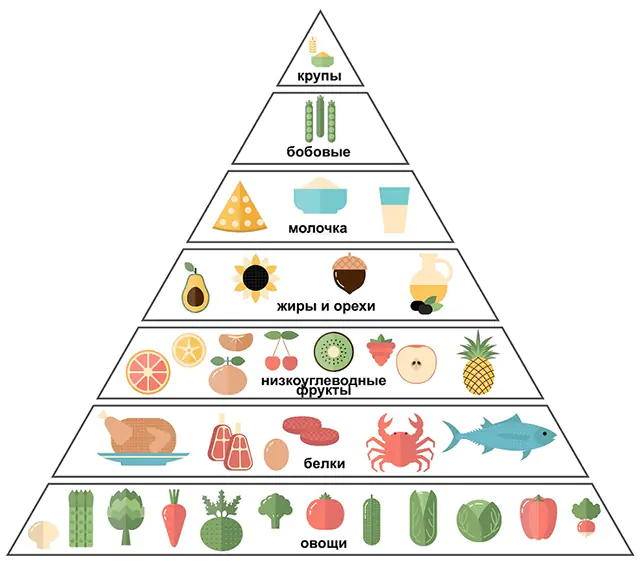
Diet for sporotrichosis is of great importance. To support the body, you need to create an environment that is least favorable for the spread of fungus. It is best to avoid foods that contain large amounts of carbohydrates, which release insulin and increase blood sugar levels. Sugar is an ideal environment for fungus to multiply.
The drugs used in the treatment of sporotrichosis cause a big blow to the liver, so you need to reduce the load on it. To do this, you need to reduce the amount of fat in your diet. Lean meat should be used in the diet; soups should be prepared without it, boiling it separately. Fish and meat can only be consumed boiled or steamed.
Dairy products should also be chosen with a reduced fat content. Spice lovers will also have to temporarily give up their addiction.
Upon completion of treatment, it is recommended to extend the diet for another couple of weeks, gradually adding previously prohibited foods.
The initial stages of sporotrichosis in humans can be successfully treated, but the disease can develop again against the background of hormone surges and decreased immunity, so prevention is necessary. To avoid becoming infected with fungus, you should use gloves when working with plants, and immediately disinfect any damaged skin. When working in the garden or with animals, you should wear protective clothing and footwear. It is important to monitor your immune system and keep it in good shape.
How to treat sporotrichosis - watch the video:



